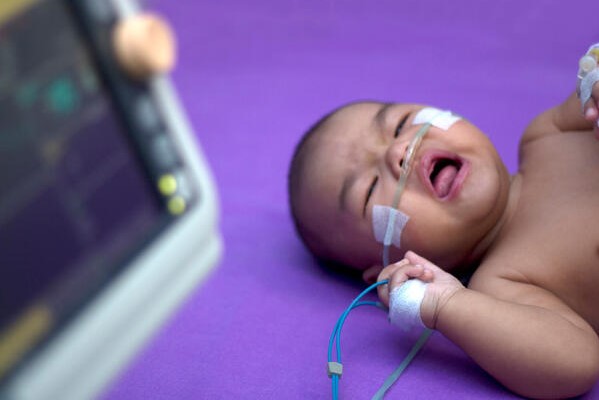
Persistent pulmonary hypertension in the newborn: treatment, prognosis, mortality
Persistent pulmonary hypertension of the newborn’ or simply ‘Persistent Pulmonary Hypertension’ (hence the acronym ‘PPH’ or ‘Persistent Pulmonary Hypertension of the Newborn’ hence the acronym ‘PPHN’) is a neonatal respiratory disorder characterised by narrowing of the pulmonary arteries in the newborn after birth, with reduced blood flow to the lungs and thus reduced circulating oxygen levels
The treatment of persistent pulmonary hypertension in the neonate focuses on two main points
- reduction of pulmonary vascular resistance (PVR);
- increase in systemic vascular resistance (SVR).
This should lead to a reduction of the right-left shunt and an increase in pulmonary blood flow.
Some neonates may respond favourably to oxygen supplementation (oxygen therapy), but most require intubation and assisted ventilation.
Treatment involves placing the infant in an environment with 100% oxygen.
It is possible for several days to add a very small concentration of nitric oxide to the oxygen inhaled by the infant, which causes vasodilation of the pulmonary arteries and reduces pulmonary hypertension.
The main aim of assisted ventilation in the treatment of PPHN is to induce respiratory alkalosis.
The respiratory alkalosis caused by hyperventilation should, in turn, lead to vascular-pulmonary dilatation when the pH exceeds 7.50.
The mediator of this ISR-lowering effect seems to be the concentration of hydrogenions and not PaCO2.
As ISR decreases, blood flow through the pervious ductus arteriosus (PDA) is reduced and pulmonary flow increases.
The agitated infant, who is not adapted to the mechanical ventilator, may experience periods of hypoxia that can worsen the right-left shunt.
In such cases, pharmacological paralysis of the respiratory muscles and sedation is recommended.
However, the use of neuromuscular blockers is not universally accepted, so some centres treat PPHN without resorting to muscle paralysis.
Infants with PPHN can be given fluids and antibiotic drugs in case of bacterial infection.
Pharmacological treatment of PPHN may also include tolazoline, a drug that has the potential to cause pulmonary vasodilation.
Tolazoline is a β-adrenergic blocker with histamine-like effect and direct vasodilator effect.
Unfortunately, the use of tolazoline in the treatment of patients with persistent pulmonary hypertension has provided conflicting results
Tolazoline is not a selective pulmonary vasodilator, so it can reduce both systemic and pulmonary arterial pressures.
If systemic pressures are reduced more than pulmonary pressures, an increase in the right-left shunt is even possible.
The clinical use of tolazoline is also limited by its complications, which include hypotension and gastro-enteric bleeding.
This drug may also cause skin redness due to significant skin vasodilation.
Severe systemic hypotension in patients with PPHN must be treated promptly as it tends to increase the pressure gradient between the pulmonary artery and the aorta and thus increase blood flow through the ductus arteriosus.
Drugs such as dopamine are used to correct hypotension.
High-frequency ventilation
High-frequency ventilation has also been used to treat PPHN.
It is most commonly used in infants with air passage through the parenchyma and the appearance of interstitial emphysema.
However, the role of high-frequency ventilation in the treatment of PPHN has not yet been clarified.
ExtraCorporeal Membrane Oxygenation (ECMO)
ExtraCorporeal Membrane Oxygenation (ECMO) is an important (in many cases life-saving) therapeutic alternative in the treatment of patients with PPHN when conventional therapeutic methods fail.
Arteriovenous ECMO is a method by which the newborn’s blood is drawn via a venous catheter and then oxygenated through a membrane oxygenator, which of course also removes carbon dioxide.
After the blood has been oxygenated, it is heated and reinfused into the patient’s arterial system.
As our staff has repeatedly found, this technique can literally save the lives of infants with severe forms of PPHN, as it allows for adequate oxygenation and a reduction in PVR.
ECMO may be indicated in the presence of unfavourable prognostic signs such as a P (A-a) O2 above 600 mmHg that persists for 12 hours.
The prognosis of persistent pulmonary hypertension varies widely depending on many features of the disease and the infant
Negative prognostic factors for persistent pulmonary hypertension in the neonate are:
- baby born very prematurely and with low weight;
- severe fetal distress during delivery (e.g. due to meconium aspiration syndrome, which is common in the post-term birth or term birth by caesarean section without labour)
- respiratory distress syndrome;
- transient tachypnoea of the newborn (neonatal wet lung syndrome);
- infection of the foetus (sepsis of the newborn);
- bronchopulmonary dysplasia;
- difficult and laboured birth;
- pulmonary hypoplasia;
- pulmonary aplasia;
- severe respiratory insufficiency;
- vascular and/or pulmonary malformations;
- low Apgar index;
- intrauterine asphyctic syndrome;
- neurological diseases;
- other pathologies: cardiovascular, pulmonary and/or systemic.
The presence of severe respiratory distress and severe bronchopulmonary dysplasia is a complication that greatly worsens the prognosis.
Possible neurological involvement (frequent in cases of intrauterine asphyctic syndrome) significantly influences the patient’s final prognosis, generally increasing both mortality and the possibility that persistent pulmonary hypertension may leave even severe, debilitating and persistent neurological sequelae.
The mortality rate of neonates with persistent pulmonary hypertension is approximately 10-60%.
The wide percentage variability depends essentially on the upstream cause of the persistent pulmonary hypertension.
Death usually results from respiratory failure.
Approximately 25% of survivors of persistent pulmonary hypertension of the newborn show
- developmental delays
- mental retardation of varying degrees;
- motor and/or sensory neurological deficits;
- a combination of the above.
Read Also:
Emergency Live Even More…Live: Download The New Free App Of Your Newspaper For IOS And Android
Obstructive Sleep Apnoea: What It Is And How To Treat It
Obstructive Sleep Apnoea: Symptoms And Treatment For Obstructive Sleep Apnoea
Our respiratory system: a virtual tour inside our body
Tracheostomy during intubation in COVID-19 patients: a survey on current clinical practice
FDA approves Recarbio to treat hospital-acquired and ventilator-associated bacterial pneumonia
Clinical Review: Acute Respiratory Distress Syndrome
Stress And Distress During Pregnancy: How To Protect Both Mother And Child
Respiratory Distress: What Are The Signs Of Respiratory Distress In Newborns?



